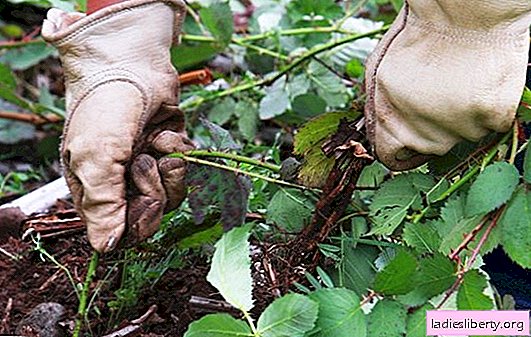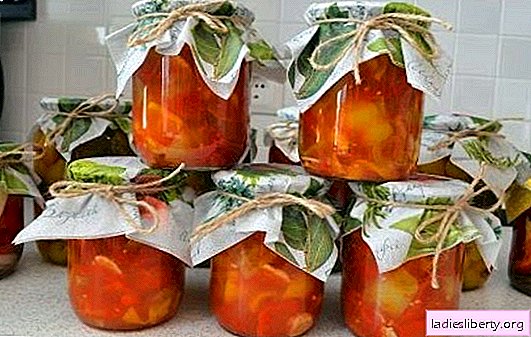
Blackberry is a distant relative of raspberries.
The fruits of this shrub are black and red, they are rich in vitamins A and C.
Like raspberries, blackberries are undemanding to growing conditions.
But for the plant to bear fruit well, regular blackberry care will be required, especially in the autumn, when the shrub prepares for winter.
How to care for blackberries in the fall?
Preparing a blackberry for the winter, you need to carry out a number of procedures: pruning, top dressing and shelter from frost. How and when to do it?
Blackberry pruning
Blackberry pruning has its own characteristics. It should be carried out regularly, which ensures the normal growth and development of the bush. The first pruning is carried out only in the second year of cultivation. Further, the bush is cut at the same interval, i.e. every two years. In adult bushes, all deflated whips are removed.

Important! If the blackberry is grown without shelter, then the lashes are shortened to a height of 1.5 meters.
Blackberry autumn pruning is carried out when the lashes die off. At the same time, one-year-old dried lashes are removed, old shoots that have repelled are cut off at ground level. In addition, you need to cut off all the extra shoots that interfere with the formation of the bush. All remaining lashes, which are expected to harvest, you need to pinch. You also need to cut damaged and diseased branches of the plant.
All garbage must be removed from the site and burned, thus protecting the blackberry from all kinds of diseases.
Fertilizing in the fall
Regular fertilization increases the winter hardiness of plants. In the autumn, it is better to feed blackberries with phosphorus-potassium fertilizers, which do not contain chlorine. Superphosphate and compost are also added under each bush. The soil after that digs well.
Important! Before applying fertilizer, the bush should be well watered.
Prepare a blackberry for winter: how to cover a plant
Blackberry belongs to heat-loving crops, therefore it does not tolerate harsh climate. If neighbors in the country claim that they grow shrubs without shelter, then do not believe it. Experienced gardeners have their own secrets for caring for the plant. First of all, you need to understand what threatens a blackberry in the winter, and then decide what to cover it with.
Cold, moisture and heat are the main enemies of the blackberry
The shrub can withstand temperatures down to -20 degrees, but with a sharp drop, even -5 will become a critical temperature for blackberries. Erect shrub varieties can withstand temperature drops of -30 degrees, but in Russia they need additional shelter from moisture. Modern varieties of creeping plants will not tolerate winter without additional shelter, since they will freeze the kidneys or root system. Of course, snow serves as a natural insulation, but you can not hope for it. After all, today there is snow cover, and tomorrow rivers flow.
When to cover a blackberry? If stable frosts are established up to -5 degrees, then it is time to prepare covering material. Estimated time of shelter is the end of October or the beginning of November. But here everything is conditional, in each region the dates may shift, depending on the weather. Earlier shelter of the shrub will only harm the plant. After all, warmth is not always a blessing! Under the influence of plus temperatures, the blackberry continues to grow and vapors. Excess moisture accumulates inside the shelter; in damp, the roots do not receive enough oxygen and begin to rot. With the advent of frost, the plant dies.
We cover blackberry: what to look for
• For blackberries, not only winters with little snow are destructive, but also thaws when frost gives way to rains. In such a climate, there is a risk of icing of the roots and buds, which leads to the death of the plant.
• Improper shelter leads to root and shoot sprouting. Under the covering material melt water accumulates, a greenhouse effect occurs. Such an environment is favorable for the development of bacteria and fungi. You can save the bush only if the tops of the shoots are backed up. It will not be possible to save the affected underground part; it is better to find new seedlings.
• Especially often, the problem of warming occurs in the southern regions, where even the first thaw will become critical. Therefore, to mulch the bush do not use moisture-consuming materials or film. It is better to use agro materials.
What does a blackberry look like in winter
Blackberries are also covered with grapes. For this, the lashes are removed from the supports, laid on the ground and pinned. Adult shoots of erect bushes bind without bending to the soil.
The main problem is the excessive wetting of the bush under the covering material. To do this, shoots are sprinkled with dry foliage, spruce branches, corn. On top of the agrofibre, a frame of boxes, fisher or plywood is installed in the form of a hut.

Important! It is necessary to cover not only plants, but also the ground under them. The more space covered, the better. After all, it is the earth that warms. Aisles also need to cover with improvised materials: film, burlap or agrofibre.
How to choose the perfect cover material for a blackberry
Before every gardener, the question arises: what is the best way to cover a blackberry for the winter? Some people prefer film, others prefer agrofibre. Each method has its pros and cons.
• The film cannot be used in the southern regions of the country when there is no stable minus in winter. Changes in temperature, thaws and moisture are detrimental to the bush. The film is used in severe winters, when the subzero temperature is maintained throughout the winter, and the snow cover will provide additional shelter.
• When covering with a film, it is important to use a layer of the mulching layer between the material and the plant. If it is not there, then the shoots will freeze.
• Agrofibre or agrotextile - non-woven material that allows air to pass through. It prevents the plant from mating even during the thaw. The disadvantages of spunbond include the ability to pass water. To avoid getting wet on top of the shelter, use mulching with spruce spruce branches, corn or dry leaves. Suitable for use in warm regions.
• Between white and dark agrofibre it is better to give preference to light, it does not heat up so much in spring.
• In the northern regions with persistent frosts, a synthetic winterizer can be used. It is laid on a layer of dry foliage. If the winter was snowy and warm, then such a shelter is not suitable.
Preparing a blackberry for winter: gardener's mistakes
1. When mulching shrubs, do not use sawdust. This is a moisture-resistant material, which with the advent of subzero temperature turns into an ice. With the advent of spring, such a shelter will warm up for a long time and sing, which leads to the death of the bush or developmental disruption.
2. Novice gardeners often mulch the shrub with straw, but this does not need to be done. Rodents settle in it, which harm the shoots and roots of the plant. In addition, in the spring, a problem arises, how to remove rotten straw from the bush.
3. If the cover material is too late to remove from the bed, then the blackberry may suffer from heat. In the spring, shelter is removed before the kidneys swell.
At first glance, autumn care for a blackberry in preparation for the winter seems difficult, but it is not. Those gardeners who have experience with raspberries, in particular preparing raspberries for the winter, can easily cope with her distant relative.











